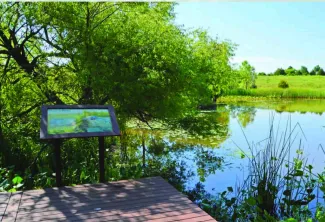Tinker Air Force Base’s 150 acres of natural reserves not only serve as wildlife habitat, they also serve as an outdoor recreation outlet and training platform for the more than 28,000 people living and working on the base. A 3.3-mile paved multi-use trail threads through the reserves and is frequently used by walkers, bikers and joggers. The trail offers a place for people to keep fit while offering a sense of solitude in an otherwise urban landscape.
The serenity in the reserves is a result of careful planning. Oaks and several other species of trees were planted around the trail to block the wind as well as the sights and sounds associated with an active military base.

John Krupovage, natural resources manager for Tinker AFB, said the greenway is a relatively new concept for an industrial Defense Department installation that “enhances the base’s standard of living and demonstrates responsible stewardship of the natural world as land is developed.”
For their roles and sacrifices in defending our nation, every airman and his or her family deserve the best standard of living – world-class facilities in a world-class environment. Our aim as a federal agency is to set the absolute standard for properly managing land and natural resources, to be a model of a productive built environment. This is not possible without a balanced approach to military build-out and natural resources stewardship.
Watchable wildlife experiences along the urban greenway are never far away. More than 300 species of wildlife have been documented on Tinker AFB. In addition to offering chance encounters with hopping toads, perching birds and sunning lizards, these natural areas also provide a place to wet a line. Five of the reserve’s 11 ponds, most of which are easily accessible from the greenway, boast excellent fishing opportunities.
Ray Moody, natural resource biologist for Tinker AFB, said, “The airmen really value these reserves. They have a good sense of environmental stewardship.”
This sense of stewardship – from the airmen all the way up to the installation commanders – is a key reason for the continued existence of Tinker’s Texas horned lizard population. Recognition of Tinker’s natural resources and the natural reserves that supply important habitat for both common and rare species has led to the development of a far-reaching management program, one that not only focuses on the wildlife resources and their habitats but also on the men and women who serve our national defense.
Learn more about the Texas horned lizards that call Tinker Air Force Base home in an article that first appeared in the March/April 2016 issue of Outdoor Oklahoma titled “Texas Horned Lizards Can’t Fly Under the Radar at Tinker Air Force Base.”